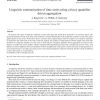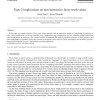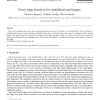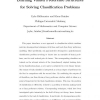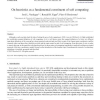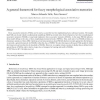90
Voted
FSS
2008
14 years 11 months ago
2008
101
Voted
FSS
2008
14 years 11 months ago
2008
We propose new types of linguistic summaries of time-series data that extend those proposed in our previous papers. The proposed summaries of time series refer to the summaries of...
FSS
2008
15 years 25 days ago
2008
Classical consistency degree has some limitations for measuring the consistency of a decision table, in which the lower approximation of a target decision is only taken into consi...
114
click to vote
FSS
2008
15 years 25 days ago
2008
In the field of classification problems, we often encounter classes with a very different percentage of patterns between them, classes with a high pattern percentage and classes w...
110
click to vote
FSS
2008
15 years 25 days ago
2008
In this paper we consider algebras of fuzzy truth values equipped with an implication operation. Generalizing the definition of type-1 fuzzy implications, we discuss extended fuzz...
FSS
2008
15 years 25 days ago
2008
The use of omnidirectional vision has increased during these past years. It provides a very large field of view. Nevertheless, omnidirectional images contain significant radial di...
111
click to vote
FSS
2008
15 years 25 days ago
2008
This paper introduces a new approach to classification which combines pairwise decomposition techniques with ideas and tools from fuzzy preference modeling. More specifically, our...
FSS
2008
15 years 25 days ago
2008
In order to obtain a demanded fuzzy implication, a number of properties have been proposed, among which the first place antitonicity, the second place monotonicity and the boundar...
106
click to vote
FSS
2008
15 years 25 days ago
2008
Although as such one dates back the idea of setting the area of soft computing to 1990, it was in 1994 that L.A. Zadeh established his worldwide accepted definition of soft comput...
106
Voted
FSS
2008
15 years 25 days ago
2008
Fuzzy associative memories (FAMs) can be used as a powerful tool for implementing fuzzy rule-based systems. The insight that FAMs are closely related to mathematical morphology (M...

